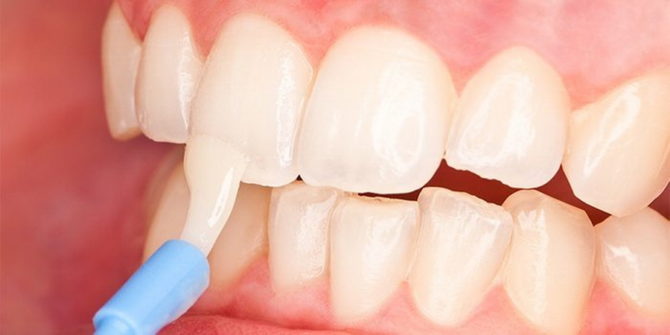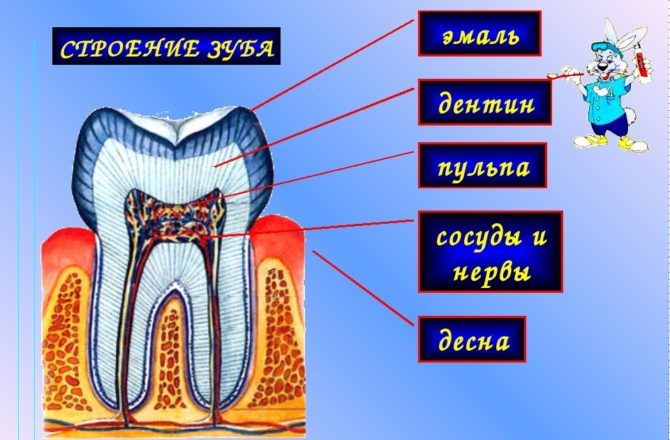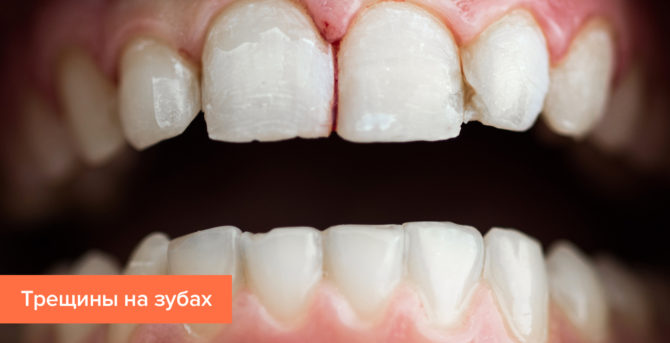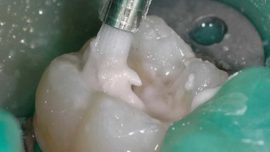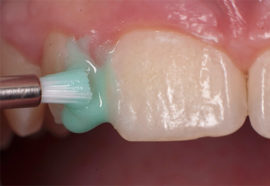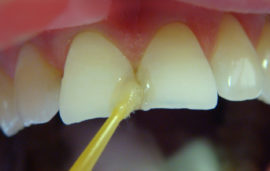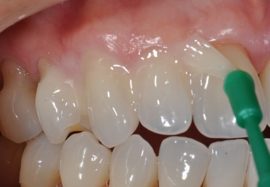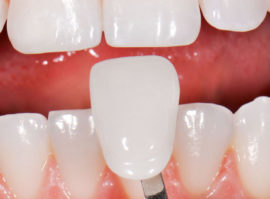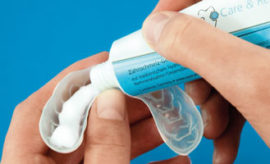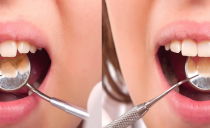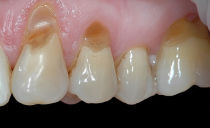Restoration of tooth enamel: in dentistry, at home
The appearance of the dentition largely depends on the condition of the outer coating of the crowns - enamel. It is a very solid substance, but, like any other biological structure, it is vulnerable. Enamel can be destroyed under the influence of food components, negative environmental factors, but most often it suffers from poor hygiene.
When a soft coating of bacteria accumulates on the tooth surface, the enamel is corroded by the products of their vital activity. Hard stones cause even greater damage - mineralized plaque. In both situations, tooth decay can be avoided by resorting to enamel restoration at the clinic or at home.
Content
The structure and composition of dental tissues
The teeth on both jaws consist of three parts: the visible upper part is a crown, a root fixed in the hole and a short neck between them. Inside there is a pulp chamber with soft tissues, nerve and blood vessels, which ensure the continuity of life support of the entire tooth. This cavity is bounded by dentin, a hard tissue that is covered with cement in the root area and enamel in the crown area.
The enamel on the tooth surface is unevenly distributed, its layer reaches a maximum thickness of a couple of millimeters in those areas of the tooth where the greatest pressure is exerted on it. Molars are abundantly covered with this fabric, which are functionally responsible for grinding food.
Unlike most body tissues, enamel contains much more inorganics: among the components there are most calcium and phosphorus compounds, as well as fluorine. Organic substances are contained in small quantities, usually their content does not exceed 5%.
Such a composition is optimal so that the enamel is strong enough and resistant to the chemical components of food. But after physical damage or erosion by aggressive substances, the enamel on the teeth is not completely restored, therefore, there are all kinds of ways to strengthen it and improve the condition.
Causes of tooth enamel destruction
For various reasons and at different speeds, tooth enamel damage occurs throughout life. The intensity of its destruction does not always depend on the person himself, since the strength and thickness of the outer coating of the tooth is a congenital sign. Even in the womb, anomalies in the structure of the dentition, which make the enamel more vulnerable, can form.
Other factors provoking the appearance of defects on the surface of the crown:
- The habit of opening bottle caps, nuts, biting threads, biting nails, stationery writing accessories, seeds with front teeth.
- Using a toothbrush with stiff bristles, toothpaste or powder with large, hard abrasive components.
- Unsuccessful attempts to restore the whiteness of tooth enamel with folk remedies or in poor dental clinics with poor quality of services.
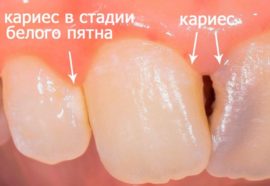 Non-compliance with hygiene, the consequence of which is the accumulation of deposits on the crown and the development of caries.
Non-compliance with hygiene, the consequence of which is the accumulation of deposits on the crown and the development of caries.- Defective diet, in which there are not enough products necessary for the normal development of bone and dental tissues.
- The ingestion of excess fluoride into the body, which leads to the development of fluorosis with characteristic spots on the crown.
- The use of harmful products for the teeth: the abuse of chocolate, sour fruits and berries, carbonated drinks.
- Metabolic malfunctions, in which the tissue does not receive enough nutrition.
- Removing part of the dentition, after which the load on adjacent teeth increases and becomes uneven.
- Changes in the composition of saliva during hormonal disruptions, in women during pregnancy.
- Smoking and injuries.
Symptoms and consequences
A person can find out that his enamel is damaged or thinned, by the following symptoms:
- Increasing the sensitivity of teeth to food temperature, its composition and taste: there is a shooting pain when eating very cold, hot, sour or sugary-sweet foods.
- The manifestation of tooth sensitivity when breathing air through the mouth.
- Chewing pain.
- Visible surface changes: the appearance of spots of various shades and shapes.
- Visible damage - chips, cracks.
If the enamel begins to thin, you need to determine the cause of the pathological process as soon as possible. Indeed, for some patients it is enough to get rid of bad habits and adjust the diet so as not to aggravate the state of enamel, and for other patients this phenomenon may be a symptom of internal disorders that require urgent treatment.
If you ignore the condition of the enamel and do not try to restore it in the clinic or at least at home, the pathological process will go inside the tooth, which is fraught with the appearance of carious cavities with all possible complications.
Enamel restoration in dentistry
In a dental clinic, tooth enamel can be restored using several methods:
| Method | Essence |
|---|---|
| Filling |
An old technique that eliminates defects in enamel. Modern clinics use durable materials with a photocuring effect. |
| Standard fluoridation |
Periodic application of fluoride preparations to the crown. The procedure is performed every 6 months. The coating accumulates on the surface without reaching the deep layers of the tooth shells. |
| Deep fluoridation | Periodic coating of the crown with fluorine and calcium preparations. This procedure prevents oversaturation of the body with fluoride. |
| Remineralization |
Periodic tooth restoration, which is carried out for a long time. On areas that have become thinner, fluoride, calcium, and certain vitamins are applied. |
| Implantation of artificial tooth enamel |
A mixture is used, which, when implanted, is firmly connected with tooth enamel. In appearance, it is indistinguishable from a real crown. |
| Tooth pads |
Plates of cermets, ceramics or composite compositions that are glued to the previously polished surface of the crown. Greater tooth grinding is necessary for installing veneers, less for thin lumineers. Composite linings have the smallest strength and have a negative effect on natural enamel. |
How much do tooth enamel restoration procedures cost
The cheapest methods of restoring the external coating of the tooth are conventional filling and restoration using composite pads. The most expensive are the lumineer pads and dental enamel implantation procedures.
| Procedure | How much (the exact amount depends on the materials used, the clinic, the degree of tooth decay and individual factors) |
|---|---|
| Filling | From 2 to 7 thousand p. |
| Fluoridation | From 100 to 200 p. for 1 procedure for 1 tooth |
| Remineralization | From 150 to 800 p. for a comprehensive procedure for 1 tooth |
| Artificial Enamel Implantation | From 6 to 10 thousand p. |
| Lining | From 2 to 50 thousand p. |
Should I go to the dentist
The tooth enamel can be restored at home, but compared to professional restoration methods, folk methods are not so effective: large and deep damage cannot be repaired independently. The main problem is that you first need to determine the cause of the thinning of the enamel, which can be hidden in internal diseases, and only then determine the optimal treatment methods.
Before experiencing folk tips and doing home procedures, it is worth consulting a dentist, as the consequences can be unpredictable.
How to restore tooth enamel at home and folk remedies
Among the home and folk methods that help partially restore the enamel, restore normal appearance and remove unpleasant sensations from hypersensitivity, the following are most popular:
- Improving the diet.
- Regular massage of the gums, which is carried out with fingertips and is needed to intensify blood circulation and tissue nutrition.
- The use of fluoride-containing regenerating toothpastes that strengthen the enamel and prevent its further destruction. When cleaning, the paste must be left in the oral cavity for at least three minutes, so that the necessary components can be absorbed into the dental tissues.
- The use of toothpastes with triclosan and copolymer - substances that provide temporary protection against the accumulation of soft plaque and its degeneration into tartar.
-
The restoration of tooth enamel at home can be carried out using special therapeutic drops with a fluorine-containing gel, which contribute to the regeneration of hard tooth tissues.
- Some herbs help to resume normal tissue nutrition: mint, fennel, cinnamon. With a mixture of this ground raw material, they brush their teeth.
- If the enamel has become thinner and more sensitive, you can chew beeswax a couple of times a week.
Enamel Strengthening Products
Tooth enamel is practically incapable of self-regeneration, but it can be replenished with the nutritional components of food and thus strengthened. If such nutrients are present in the diet, the risk of abrasion or destruction of the outer shell of the tooth is reduced. Therefore, we must not forget about healthy products that saturate the teeth with the necessary substances.
| Essential component for dental tissue | What products contain |
|---|---|
| Calcium | Dairy products, ground eggshells, eggs, almonds, sesame seeds, bananas. |
| Phosphorus | Dairy products, peanut butter, cereals, garlic, legumes. |
| Fluorine | Drinking water, tea, sea fish. |
| Vitamin C | Citruses (in reasonable amounts), rose hip, sweet pepper, strawberries, currants. |
| Vitamin D | Red caviar, fish, beef liver, eggs. |
Dentists Recommendations
You can restore tooth enamel both in the clinic and at home, but a very important part of this process is the behavior of the person himself. To maintain the health of the oral cavity, you must always take care of yourself, notice bad habits on time and stop them right away. Adults need to monitor children's behavior and teach them the basics of hygiene.
Enamel thinning can be prevented by following these guidelines:
- You should protect your teeth from any unnecessary physical impact, including from your habits, open bottles with them, bite off the threads. If possible, injury should be avoided.
- Food should be moderately tough, do not abuse soft foods, as fibrous fruits help remove plaque.
- You can not allow a sharp change in temperature, for example, drink chilled ice cream with hot coffee.
- The habit of brushing your teeth should be formed from childhood and should be carried out regularly. If you skip this hygienic procedure a couple of times, all the accumulated soft plaque is mineralized and becomes hard dental deposit that destroys the tooth coating.
- There should not be an excess of sweets in the diet, and after each use it is advisable to rinse your mouth with water or restoring pharmacy products.
Tooth enamel is restored naturally, but if this tissue is destroyed or worn, it does not regenerate by itself.Therefore, a person should take care of the health of the dentition all his life, strengthen the enamel and try not to harm it.
If you carry out the restoration of tooth enamel in dentistry or follow popular advice, you can significantly improve the structure and appearance of the crowns. With severe damage, it is possible to eliminate defects in the anterior teeth due to the installation of artificial implants and pads. If the enamel collapses quickly and very badly, you must definitely look for the cause of the pathology.

